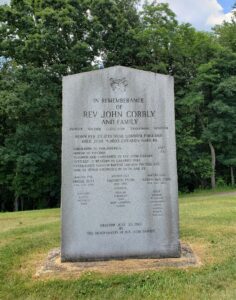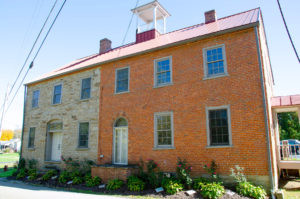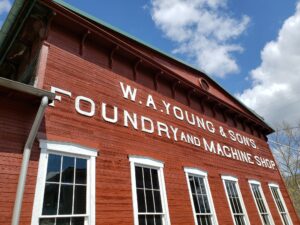Haunted in Greene
Massacres
Greene County was once a part of the frontier of European settlement in America. Life was hard and full of difficulties: land to be cleared, crops to plant, homes to be built, and chores from sunup to sundown. Adding to the settlers’ tough lives, uneasy relations between European settlers and area natives made maintaining a safe homestead a sizable concern.
Multiple well-known homestead massacres occurred in the area during these frontier times, shedding blood on the ground and leaving lasting impressions in both natural and supernatural history. Besides the massacres in white settlements, the area has a rich history of Native American burial mounds, which were often disturbed by European settlers as they built their homes. These disturbances are also thought to be part of the area’s paranormal activity.
The Spicer family, comprising William and Lydia Spicer and their seven children, were attacked by warriors while working their homestead. All but two of the children were killed. Survivors Elizabeth and William were captured, separated, and lived with the natives. Elizabeth eventually returned home, but William embraced his adopted lifestyle.

In 1782, the Corbly family, the Reverend John Corbly, his wife, and five children were walking to a nearby church when they were attacked. Corbly, walking a short distance behind the rest of his family, and two of his daughters survived the attack, although one would die young from the wounds sustained at the time. A monument for the Corbly massacre is in the Garards Fort Cemetery.
The Davis family, living in what is now Ryerson Station State Park, were attacked in 1787. Out of the family of 12, seven were killed in the cabin and Mrs. Davis and her infant daughter were captured. The infant was later found deceased, and they assumed that Mrs. Davis also died sometime after the attack, bringing the total to nine deaths. Reports from the Lazear home that sits in the park include strange sounds. Spectral apparitions of a little girl and people in period clothing have been seen in the approximate area of the massacre. While the Lazear home is not open to the public, most other areas of Ryerson Station State Park are open for the public.
Perhaps the most well-known of Greene County’s massacres is the story of the Crow sisters. In 1791, four of the Crow sisters, Lisbeth, Susan, Katherine, and Christina (name spellings vary by account), were on the way home when they were attacked by two Native Americans and a white man — believed by some to be William Spicer, survivor of the Spicer massacre. Lisbeth and Susan perished at the scene and Katherine, mortally wounded, succumbed to her wounds a few days later. Christine, who had broken free and ran, was struck in the back and left for dead but survived. The rock that sheltered the sisters has stood as a monument to the massacre, although it now sits about 100 feet from its original location. Many reports of the paranormal occur in the area: passersby and investigators have recounted screams, spectral sightings of Native Americans and more. Crow Rock is open to the public.
Haunted Historic Locales
The Hartley Inn, built in 1847, on South Market Street in Carmichaels, has a long history and many tales of paranormal encounters. An apparition is often seen, heard, or felt in the Inn by employees and patrons. The apparition frequently greets people with a puff of air across the back of their neck. It sometimes mimics the voices of others. Others have seen the apparition walking around in different parts of the Inn, as well objects moving without explanation.

Home to the annual Carmichaels Covered Bridge Festival, the Greene Academy of Art is located next to Laurel Point Cemetery. Both the historic building and cemetery grounds have been sites of paranormal activity. Disembodied voices and sounds, as well as phantom apparitions have been found in the area.
Along Rolling Meadows Road in Waynesburg, the Greene County Historical Society Museum was once the county’s poor farm. The home opened in 1862 and housed the area’s poor for over a century. Besides the impoverished, the farm eventually served almost as an asylum, housing those to mentally unstable to go anywhere else. Cruel overseers, chained inmates, lack of proper medical care, and overcrowding led to a tragic and violent history — often seen in locations with strong paranormal activity. Both visitors and staff have reported unexplained sounds, smells, and apparitions on the grounds, as well as feelings of uneasiness. The museum’s haunted history has been explored on various paranormal television shows.
The Denny House, also located in historic Waynesburg, is part of the town’s rich past. And like the rest of the town, it comes with some unexplained activity of its own. The house was built before the Civil War. It was remodeled into its current appearance by Eleazer Luse Denny and his family and restored as an event center by its current owners, Pam and Kent Marisa. Visitors at the house have reported apparitions, unexplained voices, and sounds, and more.
Other Waynesburg supernatural occurrences include the apparition of Thomas Slater, who died in the early 19th century, the haunted grounds of Waynesburg University, spectral dogs and humans, unexplained happenings in many downtown businesses.

The historical W.A. Young & Sons Foundry and Machine Shop in Rices Landing is a hotbed of paranormal activity. The Foundry and Machine was once an important part of Rices Landing industry. It services the steamboats that traveled the Monongahela River, and eventually the coal mines lined the river’s sides. Visitors, staff, and paranormal investigators have seen and heard things they cannot explain: the sounds of someone whistling, objects moving on their own, other sounds, and ghostly specters.
The Foundry and Machine Shop is just the beginning in Rices Landing. The Legend of Stovepipe is based in the Rices Landing area. Other locations in the area, such as the Greene River Trail, the fire hall, the former jail, and the borough building, have had unexplained sounds, moving objects, and ghostly apparitions. The area is also the site of the tragic, and still unsolved, murder of eight-year-old Debra Makel.
Continuing south along the river, travelers can visit the former coal town of Nemacolin. Once operated as Buckeye Coal Co. the Nemacolin Mine was thought to be the largest in the United States in 1919 and was considered a model coal mining community. And while the mine idled in 1986 and was sealed shortly after, that hasn’t stopped the supernatural stories often associated with coal mining towns. Apparitions, both human and animal, have appeared before homeowners in the forests that surround the town and even their own homes. Strange screams and sounds can often be heard in different parts of the town at night and sightings of strange creatures continue to occur.
Want to learn more about the haunted history and happenings in Greene County? Check out Kevin Paul’s Haunted Hills and Hollows: What Lurks in Greene County, Pennsylvania book series for more accounts of the supernatural!







